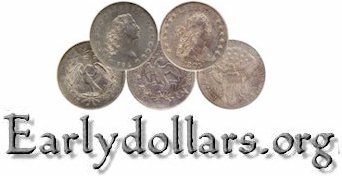

|
Production of Flowing Hair dollars dated 1795 employed 10 known different obverse dies and 11 known different reverse dies, combining to create 19 different individual die varieties. The Redbook groups these varieties into two basic categories based upon the appearance of the wreath on the reverse surrounding the eagle. The so-called “two-leaves” variety depicts smaller, more delicately structured leaves with two leaves showing prominently on the inside of the wreath beneath each of the eagle’s wings. An estimated 3,500 specimens of the two leaves type are thought to still be in existence in all grades combined, making it somewhat scarcer than the so-called “three leaves” type. |
||
|
|
||
|
Two Leaves Reverse |
||
|
The “three-leaves” variety depicts larger, heavier leaves with three leaves showing prominently on the inside of the wreath beneath each of the eagle’s wings. An estimated 4,200 specimens of the three leaves type are thought to still be in existence in all grades combined, making it somewhat more available than the two leaves type. |
||
|
|
||
|
Three Leaves Reverse |
||
|
The Redbook also recognizes a “silver plug” variety, which is not actually a distinct die variety itself, but, rather, is an artifact of production. During the early years, the Mint did not possess the technology to produce coin planchets or blanks of precisely the required weight every time. Some planchets were too heavy, and Mint employees would use rough files to scrape off some of the precious metal to reduce or adjust them to the correct weight. The resulting “adjustment marks” are quite common among early dollars, especially the very first years. By contrast, with the silver plug coins, the planchets were too light to start with, and rather than wasting the time to remake the planchet from scratch, Mint employees would drill a hole near the center of the planchet and insert a plug of silver to raise the weight to the correct level. Once the coin was struck, the plug would flatten out and become less apparent, visible only by a difference in toning from the rest of the coin, or a slightly perceptible border along the edge of the plug. Silver plugged specimens are known to exist in several die varieties. It is unknown just how many such Mint-made silver plugged dollars exist today. Experts estimate the number at between 30 and 80 - making them quite rare indeed. |
||
|
|
Silver Plug Dollar |
|
|
In addition to the distinctive features recognized in the Redbook, Flowing Hair dollars of 1795 also display distinctively different styles of the obverse portrait of Miss Liberty. The so-called “Head of ‘94” style displays a portrait rather similar to that used on the 1794 dollar, with the tip of the neck ending in a more blunt or rounded fashion. There is also a noticeable “pinch” in the middle of the truncation of the neck, and there is no loop beneath the truncation. Also, the highest hair curl at the back of the head is thin. On varieties bearing the “Head of ‘95” portrait style, there is a distinct dissimilarity to the portrait style of the earlier 1795 and 1794 dollars. Note how the tip of the neck now ends in a sharp point. There is no longer a noticeable “pinch” in the middle of the truncation of the neck, and there is a loop beneath the truncation. Also, the highest hair curl at the back of the head is thick. |
||
|
|
|
|
|
Head of ‘94 |
Head of ‘95 |
|
|
On the “Hidden Star” variety, there is an unusual arrangement of the obverse stars. One of the stars is positioned completely beneath the tip of the bust of Liberty, and so is “hidden” from her view. |
||
|
|
||
|
Hidden Star |
||